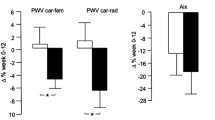Abstract
Ankle oedema is a common adverse event during treatment with dihydropyridine (DHP) calcium channel antagonist therapy, the incidence of which is dose related. The three mechanisms put forward to explain the formation of oedema during calcium channel antagonist therapy are arteriolar vasodilation, impairment of the local vascular autoregulation of blood flow and impaired protection against hydrostatic load. The importance of differential arteriolar-venular dilation has been demonstrated in numerous clinical studies. In particular, differences in sympathetic overactivation after arterial vasodilation have been shown to be related to differences in ankle oedema rates. If these results are confirmed, calcium channel antagonists that activate the sympathetic nervous system to a lesser extent, such as manidipine, may become first-choice calcium channel antagonists because of their more favourable adverse event profile.





Similar content being viewed by others
References
Opie LH. Calcium channel antagonists. Part IV: Side effects and contraindications drug interactions and combinations. Cardiovasc Drugs Ther 1988; 2: 177–89
Messerli FH, Feng Z, Grandman AH. Combination therapy of calcium antagonists and ACE inhibitors-the incidence of vasodilatory oedema [Abstract]. Am J Hypertens 1999; 12: 119A
Papavassiliou MV, Vyssoulis GP, Karpanou EA, et al. Side effects of antihypertensive treatment with calcium channel antagonists [Abstract]. Am J Hypertens 2001; 14: 114A
Fogari R, Zoppi A, Lusardi P, et al. Efficacy and tolerability of manidipine hydrochloride in the long-term treatment of mild-moderate hypertension: Manidipine Efficacy in Long-Term Treatment Group. Blood Press 1996; 5 suppl. 5: 24–8
Gustafsson D, Lanne T, Bjerkhoel P, et al. Microvascular effects and oedema formation of felodipine in man. J Hypertens 1989; 7 suppl. 4: S161–7
Van Hamersvelt HW, Kloke JH, de Jong DJ, et al. Oedema formation with the vasodilators nifedipine and diazoxide: direct effect or sodium retention? J Hypertens 1996; 14: 1041–5
Lund-Johansen P, Stranden E, Helberg S, et al. Quantification of leg oedema in postmenopausal hypertensive patients treated with lercanidipine or amlodipine. J Hypertens 2003; 21: 1003–10
Pedrinelli R, Dell’Omo G, Nuti M, et al. Heterogeneous effect of calcium channel antagonists on leg oedema: a comparison of amlodipine versus lercanidipine in hypertensive patients. J Hypertens 2003; 21: 1969–73
Tikhonoff V, Mazza A, Casiglia E, et al. Differential effects of manidipine and lercanidipine on blood pressure, peripheral circulation and ankle oedema in hypertensive patients [Abstract]. J Hypertens 2004; 22 suppl. 2: 244
Fogari R, Malamani GD, Savino S, et al. Effects of different dihydropyridine calcium antagonists on pretibial subcutaneous tissue pressure in hypertensive patients [Abstract]. Am J Hypertens 1998; 11: 114A
Gustafsson D. Microvascular mechanisms involved in calcium antagonist oedema formation. J Cardiovasc Pharmacol 1987; 10 suppl. 1: S121–31
Messing M, Van Hessen H, Smith TL, et al. Microvascular actions of calcium channel antagonists. Eur J Pharmacol 1991; 198: 189–95
Fogari R, Zoppi A, Corradi L, et al. Effects of different dihydropyridine calcium antagonists on plasma norepinephrine in essential hypertension. J Hypertens 2000; 18: 1871–5
Fogari R, Malamani GD, Zoppi A, et al. Manidipine has less oedematigeneous potential than amlodipine [Abstract]. J Hypertens 2000; 18 suppl. 2: S154–5
Author information
Authors and Affiliations
Corresponding author
Rights and permissions
About this article
Cite this article
Fogari, R. Ankle Oedema and Sympathetic Activation. Drugs 65 (Suppl 2), 21–27 (2005). https://doi.org/10.2165/00003495-200565002-00004
Published:
Issue Date:
DOI: https://doi.org/10.2165/00003495-200565002-00004




